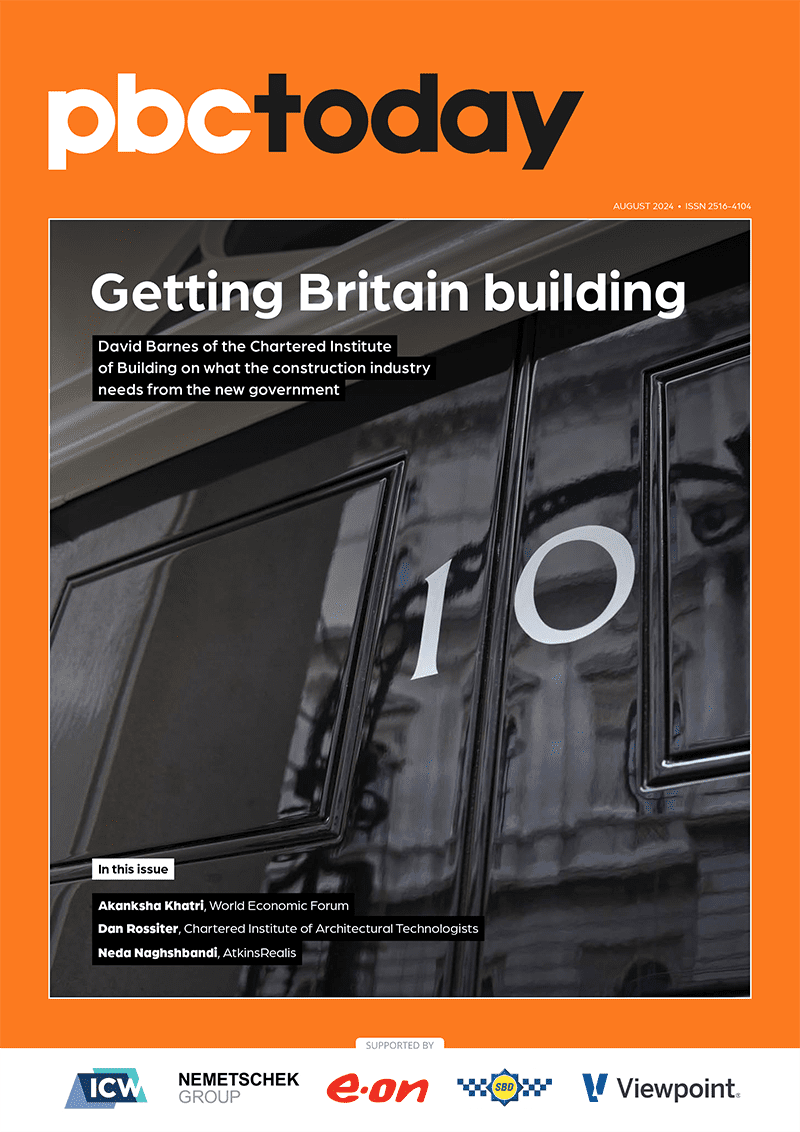Welcome to the August 2024 edition of PBC Today. In this issue, we examine what the construction industry needs from the new government to “get Britain building”, why embodied carbon is the key to truly net zero buildings and the role of the UK BIM Framework in supporting the “Big Three” of built environment policy
In our PBC Today August 2024 cover story, David Barnes, head of policy and public affairs at the Chartered Institute of Building calls on the new Labour government to provide stability and long-term policymaking – not just more reports on the problems we face.
Steve Marr, UK compliance director for SIG, discusses the Code for Construction Product Information and its mission to raise industry standards by aligning product descriptions.
Meanwhile, Akanksha Khatri, head of nature and biodiversity at the World Economic Forum, looks at new guidance that sets out five priority actions for the cement and concrete industry to transform their business practices and contribute to a “nature-positive” economy.
With the Olympics in full swing, Roderick Bates of Chaos looks at the role of architectural planning technology in delivering long-term economic, environmental and social impacts in three host cities: London, Tokyo and Paris.
Dr Anastasia Mylona, technical director at CIBSE, argues that Building Regulations must go beyond operational carbon assessments to include embodied carbon if the UK is to meet its net zero commitments.
In BIM & Digital, Dan Rossiter of the Chartered Institute of Architectural Technologists looks at the role of the UK BIM Framework in supporting greater productivity and improving sustainability in the context of the “Big Three” of built environment policy: The Construction Playbook, National Infrastructure Strategy and TIP: Roadmap to 2030.
We also hear from Clare Taylor on BIM4Water making the case for standardised Product Data Templates in the water industry’s journey to net zero, while Neda Naghshbandi of AtkinsRéalis says unlocking the promise of automation and AI will require a rethink of how we approach safety.
In MMC & Offsite, we look ahead to Futurebuild 2025 and its theme of “Impact”, while Jackie Maginnis looks back on 80 years of the Modular & Portable Building Association and Martin Harvey of McAvoy discusses breaking down barriers in modular design.
There is much more besides. Here’s a selection of what’s in this edition:
1. Getting Britain building: What does the built environment need from the new government?
Construction industry needs solutions, stability and long-term policymaking from Sir Keir Starmer’s government, not just more reports on the problems we face, says David Barnes, head of policy and public affairs at the Chartered Institute of Building
2. How cement and concrete companies can contribute to a nature-positive economy
Akanksha Khatri, head of nature and biodiversity at the World Economic Forum, looks at new guidance that sets out five priority actions for the cement and concrete industry to transform their business practices and contribute to a “nature-positive” economy.
3. Past, present and future: 3 megaproject blueprints to help achieve net zero 2050
Professor Adam Boddison OBE, chief executive of the Association for Project Management (APM), examines three megaprojects – London 2012, HS2 and Zero Carbon Humber – that provide successful template for built environment professionals on the road to net zero.
4. A tale of three cities: How architecture can save the Olympic Games
Bidding for and hosting the Olympic Games comes with a massive cost – and too often, facilities have faced an uncertain future once the flame has gone out. However, writes Roderick Bates of Chaos, London, Tokyo and Paris show that with careful architectural planning and technology, the Games can deliver long-term economic, environmental and social impacts.
5. Why embodied carbon is the key to truly net zero buildings
There is a need for Building Regulations to extend beyond operational carbon assessments to include embodied carbon if the UK is to meet its net zero commitments. Dr Anastasia Mylona, technical director at CIBSE, explains how this could be approached.
6. Women’s work: Challenging perceptions of female engineers
Issues around everyday sexism remain prevalent in engineering, and with the proportion of women working within the industry decreasing in the past year, it’s clear that while progress has been made, there is still has a long way to go.
7. Building competence in supply chains: The impact of the Building Safety Act 2022
Alex Minett, global head of new markets at Veriforce CHAS, explores the role of competence in the new Building Safety Act and offers insight on how organisations can foster competence throughout their supply chains.
8. The UK BIM Framework: Supporting the Big Three of built environment policy
The Construction Playbook, National Infrastructure Strategy and TIP: Roadmap to 2030 have set the priority areas for the built environment – but productivity remains a key challenge. Dan Rossiter of the Chartered Institute of Architectural Technologists says the UK BIM Framework can support organisations in boosting output, cutting costs and improving sustainability.
9. Digital twin of the Qutub Shahi Tombs protects its past and ensures its future
A digital twin of the Qutub Shahi Tombs in Hyderabad, India, gives a new lease of life to this important cultural site – identifying areas for restoration and potentially providing future tourists with a novel VR experience, explains Rajesh Dhyani, executive director of R&D, Hexagon Geosystems.
10. What does the future of modular construction look like?
In 2022, Des Duddy of Protrade predicted a golden year for modular and offsite – but the promising picture has largely failed to materialise. Despite the setbacks, he explains why he believes the sector still has a big role to play in solving some of construction’s biggest challenges.


